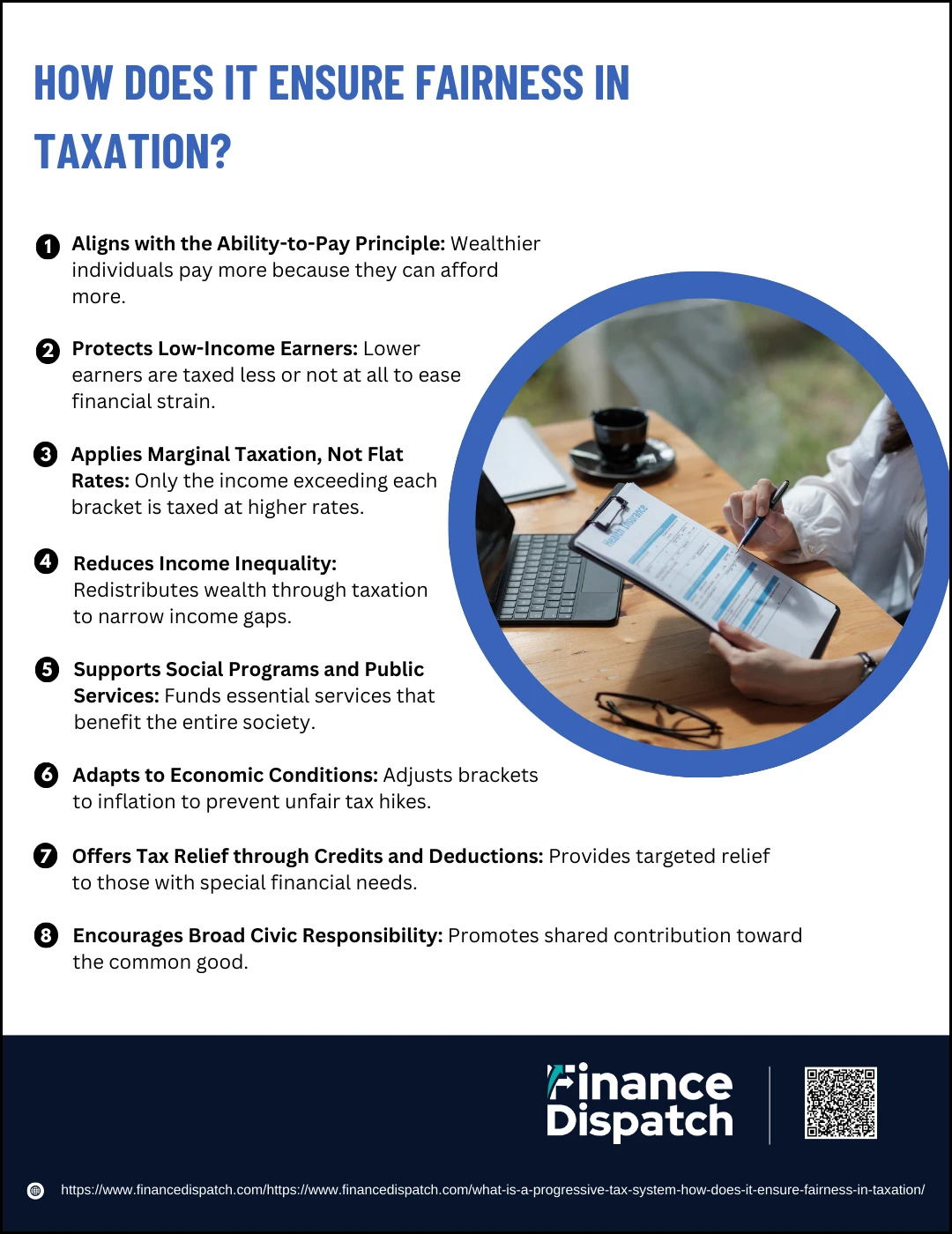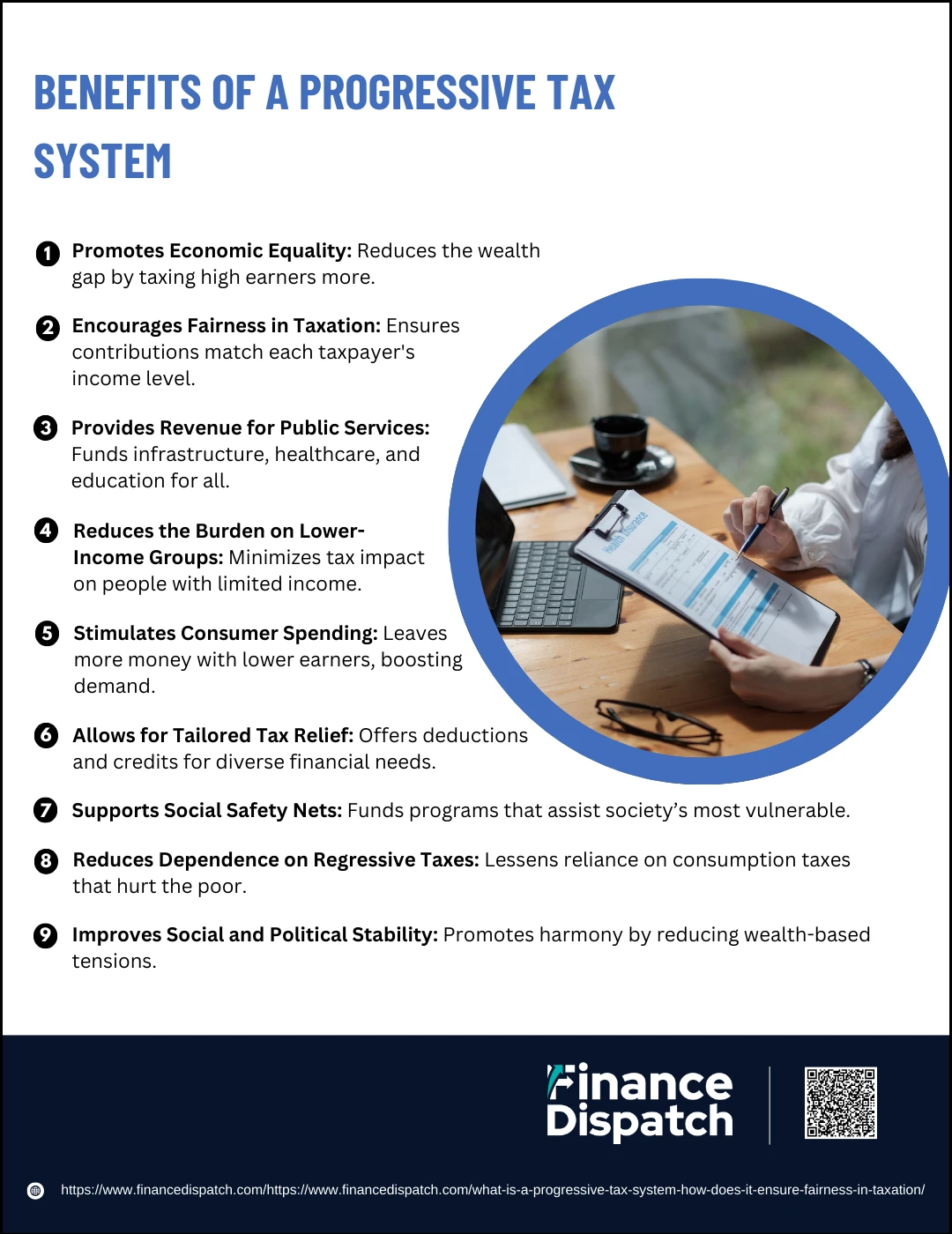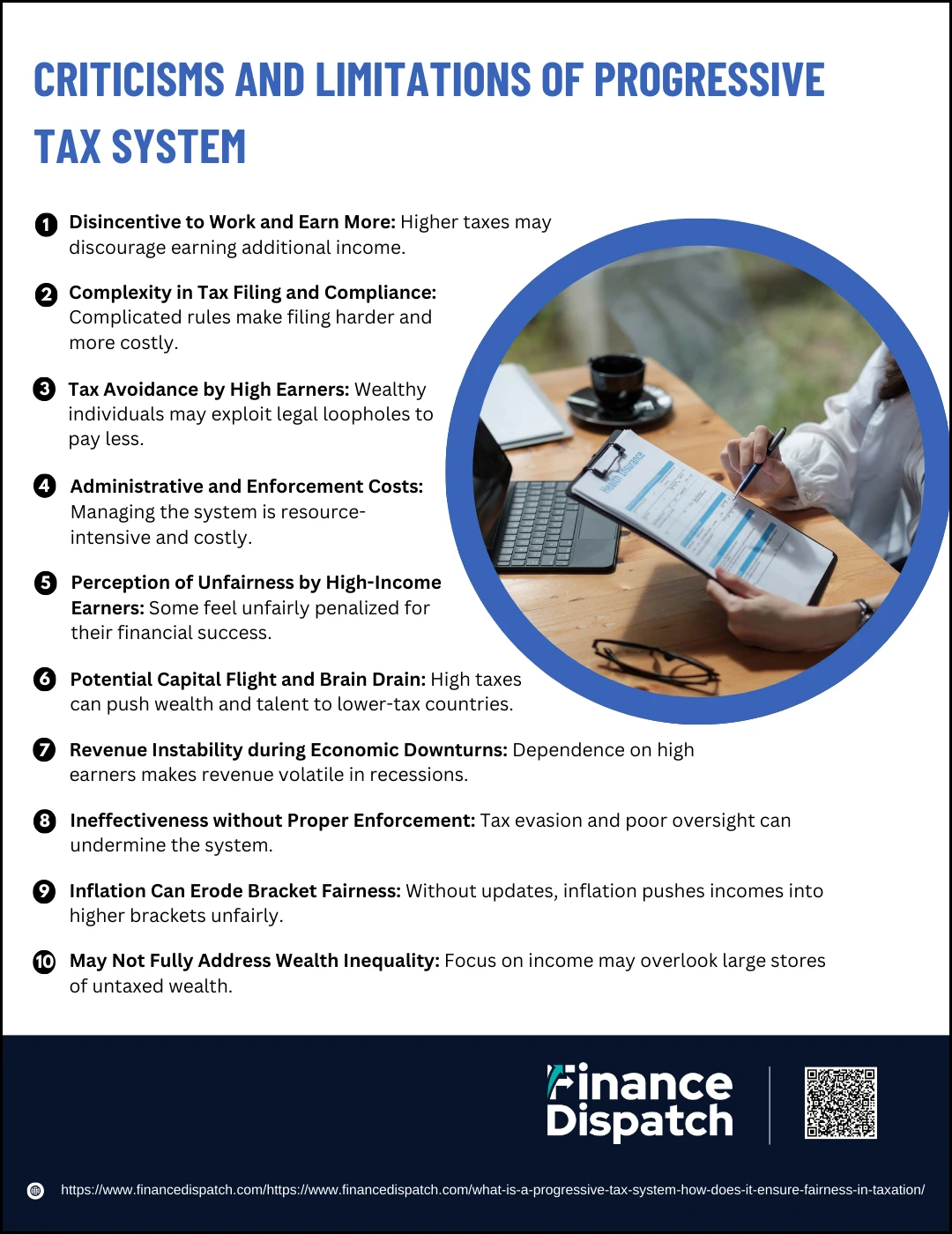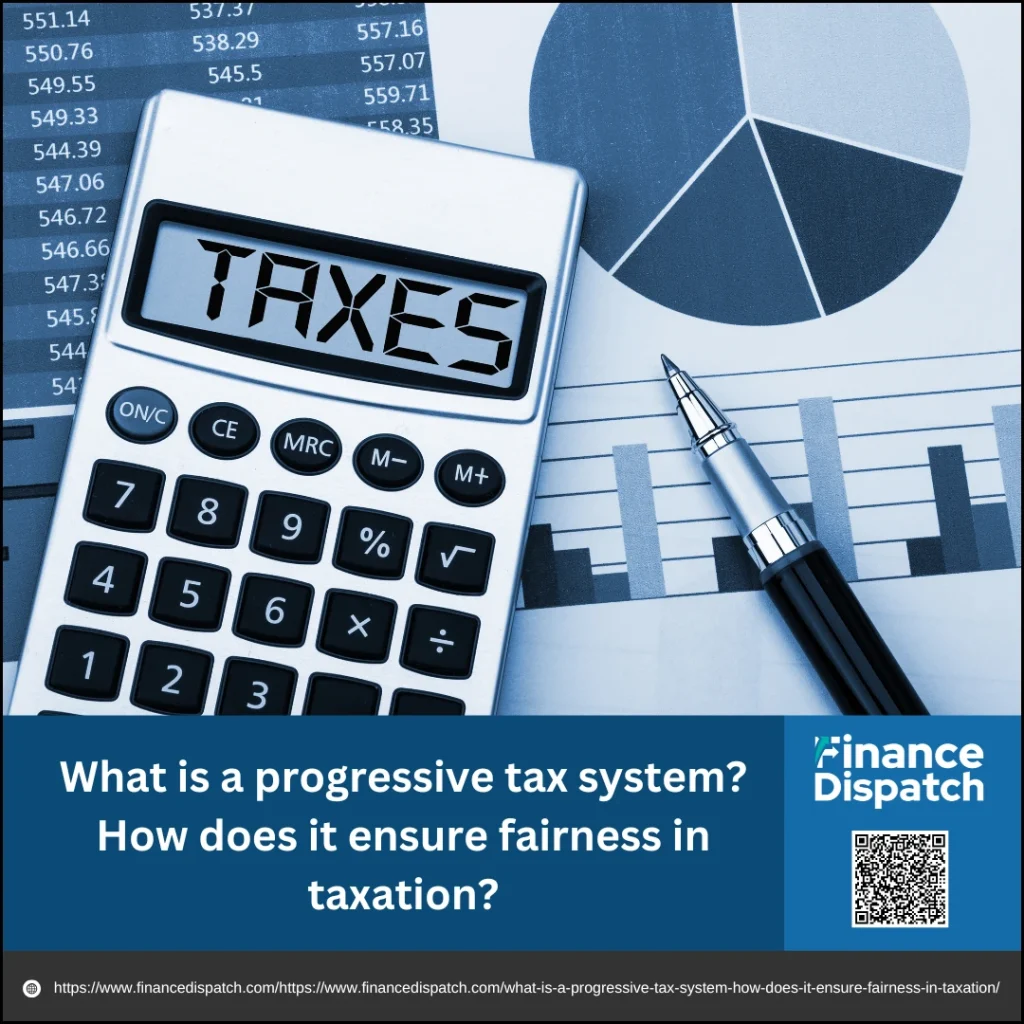In any society, taxation plays a critical role in funding public services and shaping economic outcomes. Among the various tax structures, a progressive tax system stands out for its attempt to balance revenue generation with social equity. By design, it imposes higher tax rates on individuals as their income increases, ensuring that those who earn more contribute a larger share. This approach reflects the principle of “ability to pay,” aiming to reduce the financial burden on low-income earners while asking more from those who can afford it. But how exactly does this system work, and in what ways does it promote fairness in taxation? Let’s explore the mechanics, benefits, and challenges of progressive taxation to better understand its role in creating a more equitable society.
What is a Progressive Tax System?
A progressive tax system is one in which the tax rate increases as a person’s income rises. Rather than applying a single flat rate to all taxpayers, this system uses a series of income brackets, with each bracket taxed at a progressively higher rate. This means that individuals with higher incomes pay a larger percentage of their earnings in taxes compared to those with lower incomes. However, it’s important to note that higher earners don’t pay the highest rate on all their income—only on the portion that falls within each bracket. This tiered approach is designed to ensure that the tax burden aligns more closely with an individual’s financial capacity, helping to promote economic fairness and reduce income inequality.
 How Does a Progressive Tax System Work?
How Does a Progressive Tax System Work?
A progressive tax system is designed to adjust the tax burden based on an individual’s ability to pay. As a person earns more, a greater portion of their income is taxed at higher rates. This system ensures that low-income earners are not overly burdened by taxes, while high-income individuals contribute more to public funds. Let’s break down the steps involved in how a progressive tax system works:
1. Determine Gross Income
This is the starting point for tax calculations. Gross income includes all earnings before any deductions, such as wages, salaries, investment income, business profits, rental income, and other taxable sources. It forms the basis on which deductions and credits are later applied.
2. Subtract Deductions and Exemptions
Deductions reduce your taxable income and can significantly lower the tax you owe. These include standard deductions, itemized deductions (like mortgage interest, medical expenses, and charitable contributions), and personal exemptions. After applying these, you arrive at your taxable income, which is the amount actually subject to tax.
3. Apply Tax Brackets
Tax brackets define the thresholds for different tax rates. A progressive system uses multiple brackets, such as 10%, 12%, 22%, up to 37% in the U.S. Each bracket applies only to a portion of income. For example, the first $11,925 might be taxed at 10%, the next chunk at 12%, and so on. The higher your income, the more brackets your earnings pass through—but each portion is taxed only at its corresponding rate.
4. Calculate Tax Owed for Each Bracket
Once income is divided into tax brackets, the tax is calculated for each portion separately. If you earn $50,000, you might pay 10% on the first $11,925, then 12% on the next portion, and 22% on the income above that—until your income is fully taxed across the appropriate brackets.
5. Sum Up the Tax from All Brackets
Add together the amounts you owe from each bracket. This cumulative sum gives you your total tax liability before any credits are applied.
6. Account for Tax Credits
Tax credits directly reduce the total tax you owe. Common credits include the Child Tax Credit, Earned Income Tax Credit (EITC), and education-related credits. Unlike deductions, which reduce taxable income, credits reduce tax owed dollar for dollar.
7. Result: Effective Tax Rate
After all deductions and credits, your final tax bill is divided by your gross income to determine your effective tax rate. This is often much lower than your marginal tax rate, which is the rate of the highest bracket your income reaches. The effective rate gives a clearer picture of what portion of your income actually goes to taxes.
Key Features of a Progressive Tax System
A progressive tax system is designed to adapt tax rates based on an individual’s income level, aiming to make taxation more equitable. Unlike flat or regressive tax systems, it imposes higher tax rates on higher earners and lower rates on those with modest incomes. This structure not only ensures that everyone contributes according to their financial capacity but also plays a role in reducing income inequality and supporting government-funded services.
Here are the key features that define a progressive tax system:
1. Graduated Tax Brackets
Income is divided into brackets, with each bracket taxed at a specific rate that increases as income rises.
2. Marginal Taxation
Only the portion of income that falls within a higher bracket is taxed at the corresponding rate, not the entire income.
3. Ability-to-Pay Principle
Taxes are assessed based on a person’s capacity to pay, ensuring that wealthier individuals contribute more.
4. Deductions and Exemptions
Standard or itemized deductions and personal exemptions lower taxable income, providing relief to low and middle-income earners.
5. Tax Credits for Lower-Income Groups
Refundable and non-refundable credits (e.g., Earned Income Tax Credit) further reduce tax burdens for eligible individuals.
6. Redistributive Effect
The system helps redistribute wealth by collecting more from higher-income earners and using the revenue for public programs.
7. Inflation Adjustments
Tax brackets are often adjusted annually to reflect inflation, ensuring taxpayers aren’t pushed into higher brackets without real income growth.
8. Support for Social Equity
Funds collected through progressive taxes often support social safety nets like healthcare, education, and welfare services.
 How Does It Ensure Fairness in Taxation?
How Does It Ensure Fairness in Taxation?
Fairness in taxation is a fundamental goal of any well-designed tax system, and the progressive tax structure is one of the most effective models to achieve it. Unlike flat or regressive systems, which apply the same or higher rates to all regardless of income level, a progressive tax system scales tax rates according to an individual’s earnings. This ensures that those who benefit most from the economy contribute more to support essential public services and societal needs. By incorporating concepts like ability-to-pay and redistributive justice, progressive taxation aims to balance economic efficiency with social responsibility.
Here’s how a progressive tax system ensures fairness in taxation:
1. Aligns with the Ability-to-Pay Principle
Progressive taxation is built on the idea that those with greater financial resources should contribute a larger share. A millionaire and a minimum-wage worker are not equally equipped to pay the same tax rate. This system ensures that tax obligations rise with income levels, promoting fairness based on individual capability.
2. Protects Low-Income Earners
By taxing lower income brackets at reduced rates—or even offering zero tax up to a certain threshold—the system minimizes the burden on individuals who may already be struggling to meet basic needs. This approach helps avoid pushing vulnerable households further into poverty.
3. Applies Marginal Taxation, Not Flat Rates
A common misconception is that high earners are taxed entirely at high rates. In truth, only the portion of income exceeding certain thresholds is taxed at higher rates. This marginal structure ensures that increases in income are taxed fairly without punishing individuals for earning more.
4. Reduces Income Inequality
By redistributing wealth from higher-income individuals to fund public goods and services, progressive taxation helps narrow the income gap. This fosters a more balanced society where access to opportunities isn’t solely determined by one’s economic background.
5. Supports Social Programs and Public Services
Progressive taxes provide governments with the resources needed to fund infrastructure, healthcare, education, and social safety nets. These programs benefit all citizens but are especially vital for those with lower incomes, reinforcing fairness and inclusion.
6. Adapts to Economic Conditions
Tax brackets in a progressive system are typically indexed for inflation, ensuring that people aren’t unfairly pushed into higher tax rates due to rising costs rather than actual income growth. This adjustment maintains fairness over time.
7. Offers Tax Relief Through Credits and Deductions
Targeted tax credits (such as for children, education, or low-income earners) and deductions reduce tax liability for those in need. These mechanisms create additional fairness by recognizing diverse financial situations.
8. Encourages Broad Civic Responsibility
A progressive system reflects a societal understanding that everyone contributes according to their means. This fosters a sense of shared responsibility where the wealthiest support the common good proportionately more—ensuring social cohesion and public trust.
Progressive Tax vs Other Tax Systems
To understand the strengths and uniqueness of a progressive tax system, it’s helpful to compare it with other major tax structures: flat, regressive, and digressive taxes. Each system has different implications for income distribution, fairness, and economic behavior. While progressive taxes increase rates with rising income, others either apply a uniform rate or decrease the burden as income grows. The table below summarizes the key differences among these systems to provide a clear picture of how they operate and impact taxpayers at various income levels.
| Tax System | Definition | Rate Behavior | Impact on Different Incomes | Example |
| Progressive Tax | Tax rate increases as income rises | Increases with income | Higher earners pay a larger percentage; lower earners pay less | U.S. Federal Income Tax, UK Income Tax |
| Flat Tax | A single tax rate applied to all taxpayers, regardless of income | Constant rate | All income levels pay the same percentage; higher earners still pay more in absolute terms | FICA Tax (U.S. Social Security up to income cap) |
| Regressive Tax | Tax that takes a larger share of income from low-income earners | Decreases with income | Low-income earners bear a heavier burden relative to their income | Sales Tax, Value Added Tax (VAT) |
| Digressive Tax | Starts as progressive but flattens at higher income levels | Rises initially, then levels off | Higher earners eventually pay a fixed rate, reducing tax impact on very high incomes | Some tax systems in developing countries |
 Benefits of a Progressive Tax System
Benefits of a Progressive Tax System
A progressive tax system is more than a fiscal tool—it’s a foundation for economic justice and social development. By applying higher tax rates to higher income levels, it reflects the principle that those who earn more should contribute more to the society from which they benefit. This system not only redistributes wealth but also strengthens social cohesion, promotes fairness, and enables governments to deliver essential services. Let’s take a closer look at the major benefits this system provides to individuals and society as a whole.
Here are the main benefits of a progressive tax system:
1. Promotes Economic Equality
Progressive taxes reduce the income gap between high and low earners by collecting a greater share of tax revenue from those with more wealth. This helps to mitigate the extremes of wealth concentration and uplift lower-income groups, fostering a more balanced economy.
2. Encourages Fairness in Taxation
The system ensures that individuals contribute based on their financial capacity. Someone earning $50,000 a year shouldn’t pay the same rate as someone earning $500,000. By charging more to those who can afford it, the tax system becomes inherently fairer.
3. Provides Revenue for Public Services
Progressive taxation helps fund infrastructure, public education, healthcare, national defense, and social programs. These services benefit all citizens, especially those who rely more heavily on government support, such as low-income families or the elderly.
4. Reduces the Burden on Lower-Income Groups
By offering lower rates (or even tax exemptions) for those with the smallest incomes, the system ensures that basic survival needs aren’t compromised by taxation. This can help reduce poverty and improve quality of life for many.
6. Stimulates Consumer Spending
Lower-income individuals tend to spend a higher proportion of their earnings on goods and services. By leaving more money in their hands through reduced taxes, progressive systems can boost consumer demand and economic growth.
7. Allows for Tailored Tax Relief
Through deductions and credits—like those for education, retirement savings, or dependents—progressive systems can be personalized to address specific financial situations, ensuring targeted support where it’s most needed.
8. Supports Social Safety Nets
With higher revenue from wealthier taxpayers, governments are better equipped to fund unemployment benefits, disability support, housing programs, and pensions, ensuring a stronger safety net for society’s most vulnerable.
9. Reduces Dependence on Regressive Taxes
Governments with strong progressive income taxes may rely less on sales or consumption taxes, which tend to hit low-income people harder. This shift improves the overall fairness of the tax system.
10. Improves Social and Political Stability
Countries with high inequality often face greater social unrest. By promoting a more equitable distribution of wealth, progressive taxation can help maintain public trust and societal peace.
11. Adjusts with Economic Realities
Progressive tax systems can be modified to respond to inflation or shifts in income distribution. Tax brackets can be widened or narrowed to maintain fairness and ensure the system evolves with economic conditions.
 Criticisms and Limitations of Progressive Tax System
Criticisms and Limitations of Progressive Tax System
While the progressive tax system is widely adopted for its goal of economic fairness, it is not immune to criticism. Detractors argue that it can discourage ambition, complicate compliance, and place an uneven burden on a narrow segment of the population. There are also concerns about its long-term economic impact, particularly in terms of investment, employment, and revenue reliability. By understanding these limitations, we can engage in more informed debates about how to refine tax policy without compromising its core values.
Here are the main criticisms and limitations of a progressive tax system:
1. Disincentive to Work and Earn More
When people know that additional earnings will be heavily taxed, they may be less motivated to seek raises, work overtime, or start new businesses. This can especially affect high-income professionals and entrepreneurs, potentially slowing innovation and economic growth.
2. Complexity in Tax Filing and Compliance
Progressive tax systems often involve numerous brackets, deductions, credits, and rules. For many individuals and businesses, this creates confusion and increases reliance on accountants or tax advisors. The added complexity also raises the risk of mistakes and unintentional non-compliance.
3. Tax Avoidance by High Earners
Wealthier individuals often have the resources to hire financial experts who can help them legally reduce their tax obligations through loopholes, trusts, and offshore accounts. This undermines the intent of the system and shifts more of the tax burden onto middle and lower-income groups.
4. Administrative and Enforcement Costs
With more moving parts than flat or regressive tax systems, progressive taxation requires extensive resources to manage, monitor, and audit. This administrative burden can strain tax authorities and increase costs for the government.
5. Perception of Unfairness by High-Income Earners
Some high-income taxpayers feel targeted by the system, believing it penalizes their success and overstates their ability to pay. This perception can lead to dissatisfaction, lower voluntary compliance, or even attempts to manipulate income reporting.
6. Potential Capital Flight and Brain Drain
In countries with very high top tax rates, skilled professionals, business owners, and investors may choose to move their wealth—or themselves—to countries with lower taxes. This outflow of capital and talent can have long-term economic consequences.
7. Revenue Instability during Economic Downturns
Since a large share of tax revenue comes from high earners, any downturn that affects their income—like a recession or market crash—can result in a significant drop in government revenue, affecting the funding of critical public services.
8. Ineffectiveness without Proper Enforcement
Even the best-designed tax code can fail if not properly enforced. When wealthy individuals evade taxes and audits are rare, the progressive system may appear unfair and lose public trust, especially if low-income earners face more scrutiny.
9. Inflation Can Erode Bracket Fairness
Without regular updates to tax brackets, inflation can push taxpayers into higher tax brackets even if their real income hasn’t increased—a phenomenon known as “bracket creep.” This effectively increases tax burdens without raising actual earning power.
10. May Not Fully Address Wealth Inequality
Progressive income taxes focus on yearly earnings but often overlook accumulated wealth such as property, investments, and inheritance. As a result, the system may not be sufficient to curb long-term wealth inequality, which is a major driver of economic disparity.
Real-World Examples of Progressive Tax Application
Progressive tax systems are widely used across the globe, each tailored to suit a country’s economic goals and social needs. They ensure that higher-income individuals pay a greater share of their income in taxes, while offering relief to those earning less. Here are some brief examples of how different nations apply progressive taxation:
1. United States: Federal tax rates range from 10% to 37%, with credits and deductions for low-income earners.
2. United Kingdom: Four tax bands from 0% to 45%, with a personal allowance that exempts low earnings.
3. Ireland: Uses 20% and 40% income tax rates, plus progressive social charges.
4. France: Multiple tax brackets up to 45%, with family-based taxation and generous deductions.
5. Canada: Five federal tax brackets from 15% to 33%, plus progressive provincial taxes.
6. Germany: Rates increase from 0% to 45%, with additional surcharges and a tax-free threshold.
7. Australia: Tax rates range from 0% to 45%, with offsets for low-income earners.
8. Nordic Countries: High marginal tax rates (over 50%) fund robust social programs and services.
How It Promotes Fairness in Taxation
A progressive tax system promotes fairness by ensuring that individuals contribute to public revenue based on their financial capacity. Unlike flat or regressive tax models, it imposes higher tax rates on those with higher incomes while easing the burden on lower-income earners. This approach aligns with the principle of “ability to pay,” recognizing that a dollar holds different value depending on a person’s income level. By doing so, progressive taxation reduces economic disparity, supports social equity, and helps fund essential services like education, healthcare, and infrastructure. It fosters a more balanced society where the tax burden is shared in proportion to each person’s means, making the system not only efficient but also just.
Conclusion
A progressive tax system stands as a cornerstone of equitable economic policy, aiming to distribute the tax burden according to individuals’ ability to pay. By taxing higher incomes at higher rates, it helps reduce income inequality, supports vital public services, and promotes a sense of social responsibility. While not without its challenges—such as complexity and potential disincentives—the system remains a powerful tool for promoting fairness in taxation. When designed and implemented effectively, progressive taxation can contribute to a more just, stable, and inclusive society where everyone plays a role in supporting the common good.



